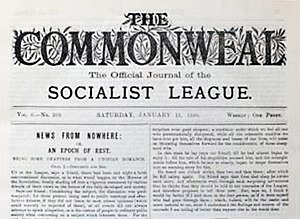Socialist League (UK, 1885)
Socialist League | |
|---|---|
Elections |
The Socialist League was an early
Organizational history
Origins
Until March 1884, the members of the Democratic Federation, forerunner of the
By the end of 1884, a group of SDF members sought to remove Hyndman from his position as party leader in December Executive Council meetings. A resolution to censure Hyndman passed by a vote of 10 to 8.[3] The anti-Hyndman dissidents handed in their prepared letter of resignation, believing the federation's lack of fraternal cooperation to be irreconcilable.[4] The 10 seceding members of the old SDF Executive Council issued a statement To Socialists in January 1885 explaining their perspective.[5]
Early in 1885, the secessionists established themselves in a new organisation called the Socialist League. Several SDF branches, such as those in East London, Hammersmith, and Leeds, joined the new group. In Scotland the Scottish Land and Labour League severed its connection with the SDF to join the new organisation.[6] Several important individuals in the movement such as author Edward Carpenter and artist Walter Crane also chose to cast their lot with the fledgling Socialist League.

In February 1885 the new party established its official journal, a newspaper called
Development
The Socialist League was a heterogeneous organisation, including
The Socialist League was involved in the fight for the right of
While the political contributions of the tiny Socialist League were not measurable, it did have a lasting literary impact. The newspaper of the Socialist League, The Commonweal, provided the venue for first publication of a number of original writings, including the serialized novels of William Morris, Dream of John Ball and News from Nowhere.[11]
In 1887, the League's membership split ideologically into three factions: anarchists, parliamentary-oriented socialists, and anti-parliamentary socialists.[12]
Anarchist control
Around the middle of this same year, 1887, anarchists began to outnumber socialists in the Socialist League.
Many of the group's international socialists began to leave. In August 1888, the London branch of the Socialist League, which included Eleanor Marx and Edward Aveling, seceded in favor of establishing itself as an independent organization, the
By 1889, the anarchist wing had completely captured the organisation. William Morris was stripped of the editorship of Commonweal in favor of Frank Kitz, an anarchist workman. Morris was left to foot the ongoing operating deficit of the publication, some £4 per week[13] — this at a time when £150 per year was the average annual family income in the kingdom.[17] By the autumn of 1890, Morris had had enough and he, too, withdrew from the Socialist League.
Disestablishment
The anarchist movement had newspapers of its own, including the journals Liberty and Freedom.[18]
The William Morris Society "reformed" the Hammersmith branch for one day on the TUC March for the Alternative on 26 March 2011.[19] The banner was paraded again on 20 October 2012.
Notable members
Secretaries
- 1885: John Lincoln Mahon
- 1885: Henry Halliday Sparling
- 1886: Henry Alfred Barker
- 1888: Fred Charles
- 1888: Frank Kitz
- 1890: Woolf Wess
Other members
|
|
|
Conferences of the Socialist League
Year Name Location Dates Delegates 1885 1st Annual Conference Farringdon Hall, London 5 July 1886 Semi-Annual Conference 25 January 1886 2nd Annual Conference 13 June 1887 3rd Annual Conference 13 Faringdon Road, London 29 May 24 1888 4th Annual Conference 13 Faringdon Road, London 20 May 1889 5th Annual Conference June 1890 6th Annual Conference Communist Club, Tottenham Court Road, London 25 May 14
Data from International Institute of Social History, "Finding Aid for the Socialist League Archive," supplemented by Kapp, Eleanor Marx: Volume 2, passim and Marx-Engels Collected Works, Volume 48, passim.
Footnotes
- ^ James C. Docherty. Historical dictionary of socialism. The Scarecrow Press Inc. London 1997. pg. 174
- ^ Beer 1929, pp. 252–253; Kapp 1976, p. 55.
- ^ Kapp 1976, p. 59.
- ^ Kapp 1976, pp. 59–60.
- ^ Kapp 1976, pp. 63–64.
- ^ Clayton 1926, p. 31.
- ^ Beer 1929, p. 255.
- ^ Beer 1929, pp. 255–256.
- ^ Kapp 1976, pp. 68–69.
- ^ Clayton 1926, p. 33.
- ^ Clayton 1926, p. 39.
- ^ Irina Shikanyan, Notes to Marx-Engels Collected Works: Volume 47, pg. 595, fn. 346.
- ^ a b c Beer 1929, p. 256.
- ^ Marx-Engels Collected Works: Volume 48. New York: International Publishers, 2001; pg. 538, fn. 95.
- ^ Frederick Engels to Friedrich Sorge, 4 June 1887. Reprinted in Marx-Engles Collected Works: Volume 48, pg. 70.
- ^ Marx-Engels Collected Works: Vol. 48, pg. 611, fn. 642.
- ^ Clayton 1926, p. 44.
- ^ Clayton 1926, p. 68.
- ^ "The William Morris Society and the TUC Day of Action". Archived from the original on 28 November 2011. Retrieved 25 July 2011.
Bibliography
External links
- Manifesto of the Socialist League, Commonweal, February 1885. William Morris Internet Archive, Marxists Internet Archive. Retrieved 14 September 2009.
- Socialist League (UK) Archives, at the International Institute of Social History. Retrieved 19 May 2018.




